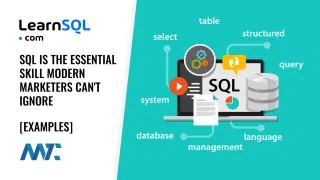A programming language specifically designed for managing and manipulating relational databases. SQL provides a standardized way to interact with databases, allowing users to create, retrieve, update, and delete data.
SQL is used to communicate with a database management system (DBMS) responsible for storing and organizing data. The most commonly used DBMS that supports SQL is called a relational database management system (RDBMS). Examples of popular RDBMSs include MySQL, PostgreSQL, Oracle, Microsoft SQL Server, and SQLite.
With SQL, you can perform various operations on a database, including:
- Creating databases, tables, and views: SQL allows you to define the structure of a database by creating databases to store related information, tables to organize data into rows and columns, and views to create virtual representations of data based on queries.
- Querying and retrieving data: You can use SQL to retrieve specific data from one or more tables by using SELECT statements. SQL provides powerful filtering, sorting, and grouping capabilities to retrieve the desired information.
- Inserting, updating, and deleting data: SQL allows you to add new records to a table using INSERT statements, modify existing records using UPDATE statements, and remove unwanted records using DELETE statements.
- Defining relationships and constraints: SQL provides mechanisms to establish relationships between tables using primary and foreign keys. You can enforce data integrity rules and constraints, such as uniqueness, referential integrity, and data type constraints.
- Performing calculations and aggregations: SQL includes various functions and operators to perform calculations and aggregations on data. These include mathematical operations, string manipulation, date/time functions, and aggregate functions like SUM, AVG, COUNT, MAX, and MIN.
SQL Example
Let’s say you have a database for a sales and marketing team that includes a table named Customers. This table has fields like CustomerID, Name, Email, PurchaseHistory, and LastContactDate. If you want to retrieve a list of customers who have made a purchase in the past year, your SQL query might look like this:
SELECT Name, Email, PurchaseHistory
FROM Customers
WHERE LastContactDate >= '2023-01-01';This query does the following:
SELECT Name, Email, PurchaseHistory: This tells the database that you want to retrieve the customer’s name, email, and purchase history.FROM Customers: This specifies that you are retrieving data from theCustomerstable.WHERE LastContactDate >= '2023-01-01': This is a condition that filters the data to only include customers who have been contacted since January 1, 2023.
The result of this query would be a list of all customers from your Customers table who have been contacted since the start of the previous year, along with their names, email addresses, and purchase history. This information can be crucial for the sales and marketing team to identify potential leads for follow-up campaigns.
SQL is a versatile language offering a wide range of capabilities for databases. It is widely used in data management and essential for developers, analysts, and administrators working with relational databases.
